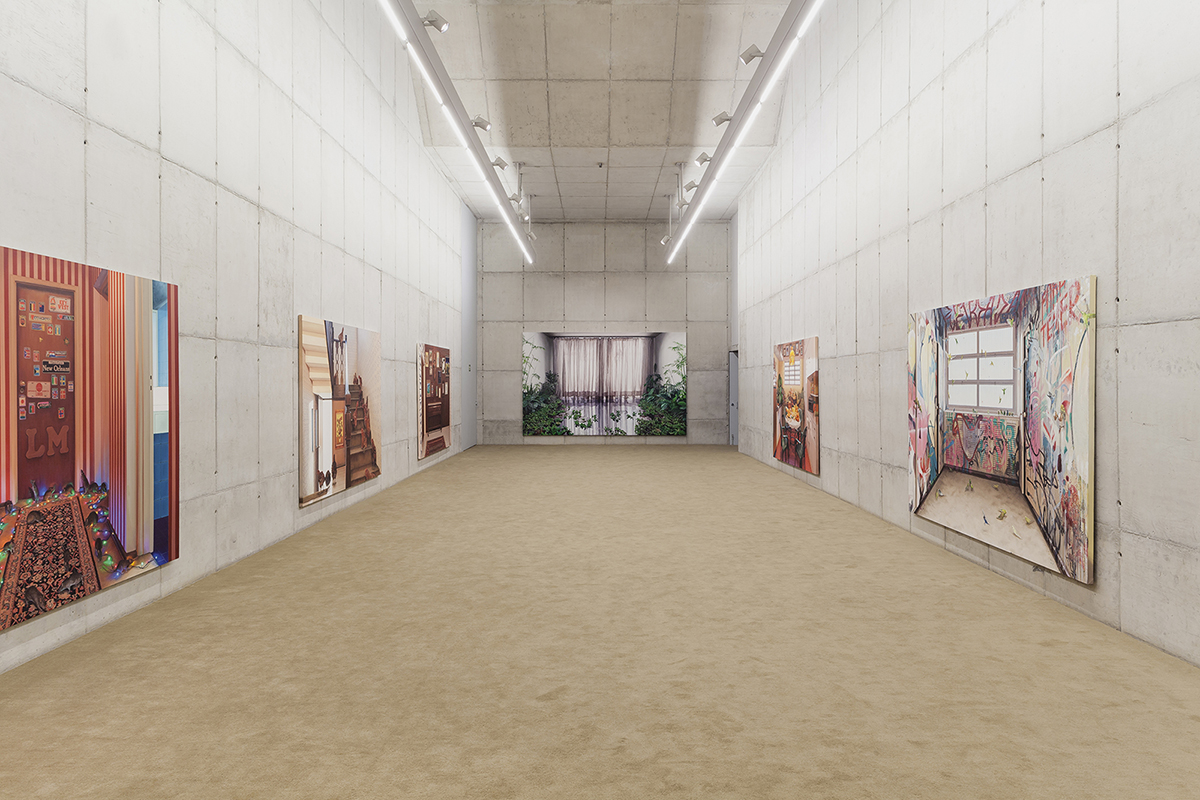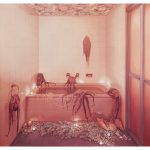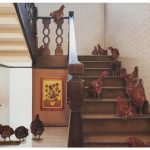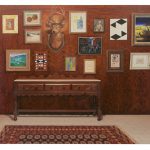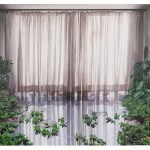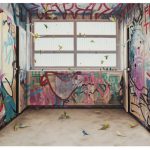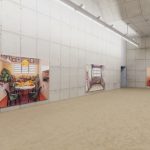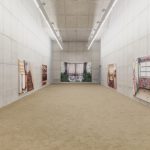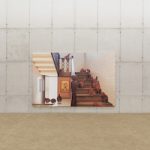Make yourself at home
We liked the house because, apart from being spacious and old (today old houses succumbed to the more advantageous sale of their materials), it kept the memories of our great-grandparents, our paternal grandfather, our parents and our entire childhood.
Julio Cortázar, House Taken Over
A house is a building to be inhabited. It is a city’s basic unit, and it is a reference of spatial belonging in the world. It is an origin and a destination, refuge and castle. In the new series of works by Ana Elisa Egreja, the house is the main character of a new phase in her pictorial research. Domestic environments and interiors have always been the artist’s subject – textures, patterns, and floor and wall drawings were recurring elements in all the situations she invented. It is interesting that none of the rooms that Egreja painted existed. Her artistic practice involved accumulating incoherent and absurd images she found in mediums like the internet, in order to create collages of scenes and architectures, which were painted in real scale.
Since 2013, the artist dedicated herself more and more to the particularities of indoor architecture, especially to textures and matters. The collage procedures gave room to still life compositions with real objects, bought, organized, staged, photographed behind small sheets of rolled glass, and then painted on small canvas. For a few years, the realization of these small sculptural installations unfolded in a modernist house that belonged to the artist’s grandmother, located on Rua Jacarezinho, 92, turned into an atelier after it had been abandoned for a few years.
To realize the paintings in this exhibition, Egreja intensely and radically intervened in that house. Although in an infinitely larger scale, she implemented the same procedure she had once developed with the still life: she elaborated themes from her persisting references, chose all the elements, arranged all the desired objects, and photographed the compositions so, then, she could paint them. However, for this ensemble, she prepared and produced the house’s occupation as a movie director on a movie set, orchestrating the scenario for a fantastic realism narrative. Each room depicted in her paintings served as a stage for real actions: she built extraordinary scenes she had previously sketched in her small notebook. She also mobilized several people in order to install, photograph and document each different quarter – almost as episodes that were mounted with different furniture, animals, pictures, accessories, transformed by graffiti and wallpaper, and professionally lit – so that she could finally translate them onto the canvas. The result is a series of figurative paintings created through a new practice, but deploying the same virtuous technique of her entire body of works.
In the bathroom of pink-colored tiles, typical of the 1950s and 60s, octopuses were rolled up on the faucets and placed inside the bathtub, surrounded by pearls and seashells lit by small flickering candles. The bedroom hallway (with its doors covered with holographic stickers) was covered with striped wallpaper, and the passageway was overrun with rats and Christmas lights. One of the wooden closets was entirely tagged and graffitied by the artist and her assistants, where they then released dozens of small bright canaries. Fat chickens walked and pecked around the bottom of the old carpeted stairs. And numerous original paintings by important Brazilian artists were brought to decorate the entry hallway. Finally, Egreja installed a large pond in one of the rooms, facing a large window, and filled it with water plants – a reinterpretation of the painting Poça (Puddle), from 2011 – creating a swamp-like landscape inside the large edifice located in the Faria Lima region. The choice of materials for these installations wasn’t based on the difficulty of painting surfaces and patterns, or finding certain kinds of animals or specific pieces, but is associated with the artist’s interest in genre paintings, especially in Dutch painting from the 17th century. She remains faithful to the recurring elements from her creative universe, preserving the same technical procedures and art history references.
A video, also born from this arduous production, is presented in the exhibition as well. An unusual medium for a painter, the documental and poetic film emphasizes real elements from the installations, to the smallest details. Images in close-up, from narrow angles, reveal the objects’ textures and nuances, while underlining seminal issues in her pictorial production. The recorded scenes allow us to witness the animals moving, the water trembling, the candles burning – stages that cannot be fully reached facing the paintings.
The works that depict the house’s environments function in the scale of architecture. By visiting the exhibition, we enter Egreja’s studio-house, which had a deep impact on her work, and is now practically transposed into the gallery. She invites us to be in the rooms she visited as a child and in which she spent most of her career and, all the more, tells us: “come in, make yourself at home”.
Julia Lima.
Julia Lima graduated from PUC-SP in Art: History, Criticism and Curatorship, and was a student at the Courtauld Institute of Art, London, in 2009. Between 2013 and 2016, she worked at the Research and Curating Center of the Instituto Tomie Ohtake, coordinated by Paulo Miyada. Today she works as an independent curator, and as a teacher in free courses in art history and curatorship.
